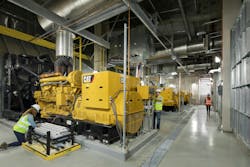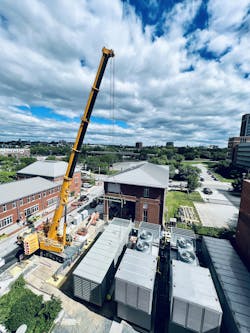Electrical Supply Chain Challenges and Solutions
Over the past three years, the global supply chain has been fraught with challenges, particularly within the architecture, engineering, and construction industry. Disruptions, such as manufacturing delays, material scarcities, shipping interruptions, workforce gaps, and regulatory obstacles, have all contributed to an increasingly complex and unpredictable building landscape. While some of these challenges have gradually begun to subside over time, the industry still faces significant hurdles when it comes to electrical equipment — switchgear and generator packages, in particular.
The scramble for materials and resources, reminiscent of the early days of the COVID-19 pandemic when even essentials were scarce, has seeped further into the availability of these pieces of equipment. The associated low-voltage power circuit breakers are now seeing the longest delays, often surpassing a year from the time a purchase order is issued. Reliance on these integrated circuits — primarily supplied by manufacturing centers in Taiwan and China — has set a cascading series of at-home challenges into motion. As a result, professionals from across the AEC industry have had to become increasingly creative with their solutions to keep necessary infrastructure online and improvement projects on track.
The burden of supply chain disruptions
The significance of the impact of electrical equipment backlogs cannot be understated. Essentials such as generator packages and switchgear lineups, which once had a standard lead time of approximately 15 weeks, are now taking more than 92 weeks to deliver. The extensive delays are impossible to accommodate within today’s tight construction timeline expectations and are far too costly to even consider. Consequently, owners, decision-makers, and engineers are forced to problem-solve even earlier in the design process — where information is extremely limited, and changes are inevitable.
Shifts in project specifications can be substantial as a concept moves through the design, development, and documentation phases — further complicating the process of accurately sizing critical pieces of equipment. Moreover, resizing that equipment can add considerably to the project timeline; every hurdle in the equipment sizing process during the mechanical engineers’ work leads to a delay or “re-do” of the electrical engineer’s sizing. When program changes occur further up the pipeline, such as from the owner or architect, the resulting domino effect sends every engineer back to the drawing board once again.
To solve for these potential setbacks and keep projects moving forward despite the “stop-rework-and-go” model, being employed out of necessity, project teams have begun procuring oversized generators and switchgear to account for the uncertainties. While prudent now, this strategy can introduce additional delays in project timelines, increased costs, and operational inefficiencies. Oversized equipment is always going to be more expensive than the right-size solution — both upfront and in terms of the ongoing energy prices and maintenance budgets.
Oversizing also raises questions about environmental responsibility that owners will have to grapple with long-term. Operating oversized equipment contributes significantly to energy inefficiencies and a larger carbon footprint, which will translate to broader sustainability questions down the line.
The far-reaching implications of this intermediate solution underscore the urgency of rectifying the challenges within the supply chain. Navigating this landscape demands creative problem-solving and unwavering dedication from engineers and decision-makers. With strategic collaboration and a little creativity, the industry can pave the way for a more efficient and robust supply chain, thus reducing the environmental footprint of its operations.
Working together toward better solutions
Owners, architects, and engineers must work together to strike a balance between mitigating uncertainties and avoiding unwarranted costs. Proactive planning is key to creating a stopgap for disruptions, and close collaboration is essential to staying ahead of volatility. Particularly for owners who may not be as familiar with the project dynamics as the on-the-ground team, this proactivity recognizes the unintentional role owners may play in overlooking how urgent decisions must be made to stay on track.
Additionally, by ensuring electrical and mechanical teams are kept in the loop on changes in real-time, the entire project team will be able to pivot strategies much faster. Equipment re-selections can be made more quickly, and the downstream processes can be expedited. In this dance, engineers can and should take the lead in advocating for what’s needed to successfully deliver a project that is both budget-friendly and quality-conscious.
When new equipment still is not a viable option, however, used generators have emerged as an effective solution. Most generators are built to support a lifespan of around 20 to 30 years. Inevitably, there will be some variability based on how well the equipment has been maintained and how often it was made to operate beyond its manufactured capacity or output. More often, the largely dependable grid infrastructure in many parts of the United States will have limited the need for generator use to power entire facilities. Many generators are only used during their mandatory testing periods and have many years left of useful life.
It is important to note, however, that while used generators represent a resourceful option that can alleviate the need for last-minute changes and can be a good place to source spare parts in a time crunch, this option becomes less feasible when paralleling switchgear is in place. Fortunately, there are other ways to strategize equipment selections that don’t require a “solve-for-this-scenario” line of thinking.
Leaning on manufacturer partnerships
While the lead time on larger pieces of equipment can stretch from 52 to 92 weeks, smaller units often have much faster manufacturing turnarounds. By working closely with the architect team, engineers can determine if the square footage needed for a two-part solution is available and pivot to the procurement of two smaller units that fulfill the same capacity initially needed from a larger, single unit. This approach also necessitates ongoing dialogue with the equipment manufacturers themselves; they know best what is available, what has the fastest lead times, what is delayed, and what the alternatives may be.
In the electrical construction and maintenance fields, the relationship between an engineer and the product and equipment manufacturers is not merely transactional; it’s a partnership,. The manufacturer will bring a discerning eye to an engineer’s designs and assist in providing equipment solutions to achieve the architect’s vision. By fostering ongoing, open dialogue, this process is as agile and adaptable as its upstream counterparts — mitigating the impact of last-minute modifications and ensuring the project stays on track the entire time.
These partnerships are also essential in better equipping the manufacturers to equip the engineers. As new products and solutions are introduced to the market and alternatives are tested and workshopped, those open lines of communication can allow for a more robust feedback loop on opportunities to improve or gaps to be filled. This is powerful data for the manufacturer to have — empowering them to evolve their development process in accordance. The benefit of that process is integral to the success of the engineer on a project, whose whole solution hinges on the manufacturer’s ability to respond. Together, this symbiotic relationship bridges the gap between what’s not working and what’s needed, helping to overcome disruptions and deliver innovative strategies efficiently.
Ultimately, each partner on the project team has an equally vested interest in its success. Engineers, in particular, play an important role in bridging vision with reality. This presents a significant opportunity to shape the trajectory of the industry and its expectations of supply chain challenges to produce more effective and efficient outcomes. By embracing open communication, advocating for collaboration, and balancing financial acumen with agile decision-making, engineers can steer projects through the complex, volatile landscape. What’s more, by better understanding and navigating the maze of shipping timelines, delivery delays, and parts shortages, engineers can help build a more sustainable future for all stakeholders involved.
As technology advances and innovation accelerates, engineers must remain adaptable and open to new solutions, further solidifying their role as pioneers in the ever-evolving landscape of industry and sustainability.
About the Author

Eric Nimer, P.E., LEED AP, PMP
Eric Nimer is an electrical engineer and RMF’s Georgia Buildings Team Lead with experience primarily in health care, higher education, and governmental projects. He also holds a Master Electrician license (unrestricted).



